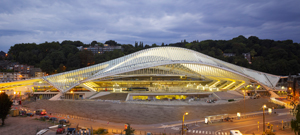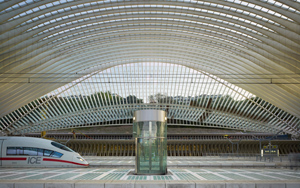 |
 |
 |
 |
 |
 |
| |
 |
|
 |
 |
 |
  |
  |
 |
 |
 |
 |
| SANTIAGO CALATRAVA: LIEGE-GUILLEMINS TGV RAILWAY STATION
|
|
September 24, 2009
 Last Friday, Santiago Calatrava has unveiled one of his most ambitious architectural projects to date; the Liège-Guillemins TGV Railway Station in Belgium. Designed by Calatrava to meet the demands of high-speed travel, the station will bring new life into the industrial city of Liège, while positioning it as the epicenter of the North European High-Speed Network Last Friday, Santiago Calatrava has unveiled one of his most ambitious architectural projects to date; the Liège-Guillemins TGV Railway Station in Belgium. Designed by Calatrava to meet the demands of high-speed travel, the station will bring new life into the industrial city of Liège, while positioning it as the epicenter of the North European High-Speed Network
The grand opening was presided over by: Prime Minister Herman Van Rompuy, international dignitaries and members of the royal family, including Prince Philippe of Belgium. Also participating in the celebration were members of the press and representatives from Euro Liège TGV and SNCB Holding including Jean-Claude Fontinoy (president), Jannie Haek (CEO) and Vincent Bourlard (general manager).
Calatrava was first commissioned to design the new Liège-Guillemins Station in 1996, after Euro Liège TGV determined that the existing station was unsuitable for the demands of high-speed rail travel. Immediately, the starchitect was faced with a seemingly impossible task; replacing the existing station without interrupting train service or disturbing the 36,000 people who frequent the facility on a daily basis. Using a technique normally employed in bridge construction, Calatrava was able to accommodate this request, while preserving the integrity of his design.
 Envisioning a building that would reflect the new station’s significance as a high-speed, inter-urban link through Europe’s cities, the architect chose to expose the working platforms and the dynamism of the moving ensemble of passengers and trains. The result is a modern station whose high-speed network will provide shorter travel times to Aachen, Cologne and Brussels, as well as to Frankfurt, Paris, London and the Southern portions of Europe, which are only a few hours away. The Station’s high-speed trains will shorten the times of travel distances considerably, provide a scenic alternative for leisure travelers and enhance the efficiency of business travelers worldwide. Envisioning a building that would reflect the new station’s significance as a high-speed, inter-urban link through Europe’s cities, the architect chose to expose the working platforms and the dynamism of the moving ensemble of passengers and trains. The result is a modern station whose high-speed network will provide shorter travel times to Aachen, Cologne and Brussels, as well as to Frankfurt, Paris, London and the Southern portions of Europe, which are only a few hours away. The Station’s high-speed trains will shorten the times of travel distances considerably, provide a scenic alternative for leisure travelers and enhance the efficiency of business travelers worldwide.
“It was my goal to create a 21st century transportation facility that would not only unite Liège with the rest of Europe, but would also serve as a symbol of the city’s renewal,” said Santiago Calatrava, designer of the Liège-Guillemins TGV Railway Station. “The project, as a whole, creates a new gateway into Liège and re-establishes a relationship with the city.”
Located within the Guillemins quarter, the new station occupies a more central position within the Meuse-Rhine Euro region and frames the city of Liège. The architect imagined a building without facades, with a soaring roof that would offer protection from Belgium’s natural elements, including its rainy winters. The effect is a flowing structure that illustrates Calatrava’s reoccurring theme of movement. “The vaulted shape of the roof was a natural development of this vision, while the soft, undulating curve was selected to mimic the graceful rise and fall of the Cointe Hills in the background,” continued Calatrava.
The Liège-Guillemins TGV Railway Station is the first part of a planned architectural vision for a corporate center in Belgium and is already asserting itself as the symbol of Liège’s renewal.
Credits
Photo © www.palladium.de, Barbara Burg/Oliver Schuh
Courtesy by Corbin & Associates, New York |
|
 |
  |
 |
|
|